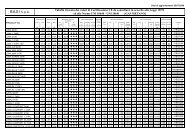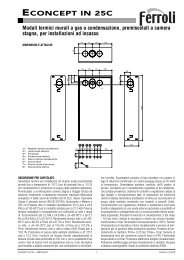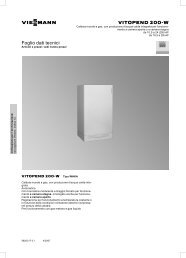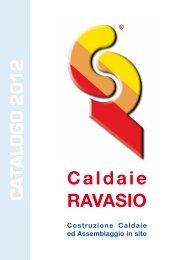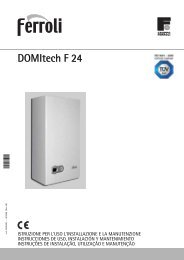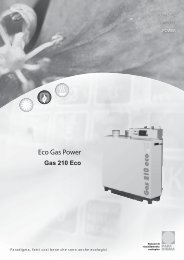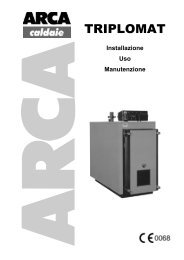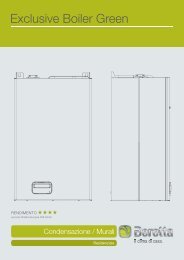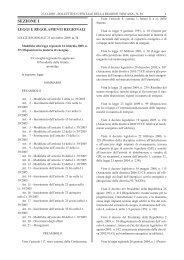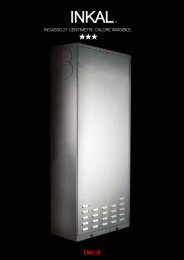aermec idrosplit - Certificazione energetica edifici
aermec idrosplit - Certificazione energetica edifici
aermec idrosplit - Certificazione energetica edifici
You also want an ePaper? Increase the reach of your titles
YUMPU automatically turns print PDFs into web optimized ePapers that Google loves.
DIMENSIONAMENTO DEL CIRCUITO • SIZING THE CIRCUIT<br />
Il dimensionamento del circuito idraulico è molto semplice<br />
e si effettua con i normali metodi, con verifica del comportamento<br />
in condizionamento e in riscaldamento della rete<br />
di distribuzione. Si faccia riferimento al capitolo “Schema di<br />
funzionamento” per un esempio di schema idraulico e per il<br />
funzionamento interno del modulo ID. In caso di un grande<br />
numero di ventilconvettori collegati, comunque, è bene<br />
eseguire accuratamente i calcoli, altrimenti si può incorrere<br />
nell’inconveniente di non alimentare adeguatamente le<br />
varie unità terminali. Viene ora proposta una procedura da<br />
seguire nei casi limite.<br />
Si consiglia, innanzitutto, di considerare per primo il funzionamento<br />
in riscaldamento in quanto questo è, con molta<br />
probabilità, il caso più sfavorevole, perchè la prevalenza<br />
che si ha a disposizione sul circuito caldo a valle<br />
dell’Idrosplit (sia che sia derivata dal circolatore di una ipotetica<br />
caldaia, che da pompe centralizzate ecc. e che in<br />
ogni caso si deve decurtare delle perdite di carico interne<br />
del modulo Idrosplit), è generalmente inferiore a quella fornita<br />
dal circolatore del modulo Idrosplit. Con questa ipotesi,<br />
con lo stesso circuito idraulico, la portata d’acqua che si<br />
instaura in riscaldamento è minore di quella che si instaura<br />
nel funzionamento in raffreddamento (mettendo in funzione<br />
il modulo Idrosplit).<br />
Nelle tav. 13-14-15-16 sono riportate, ad esempio, le rese<br />
termiche alle varie portate d’acqua per i ventilconvettori<br />
della serie FCX (tav. 21-22-23-24 per la serie FCD), riferite<br />
ad un ∆t tra acqua ed aria in ingresso. In ambienti residenziali<br />
si consiglia il dimensionamento con temperatura acqua<br />
in ingresso pari a 50 °C. Quindi, considerando una temperatura<br />
dell’aria in ingresso pari a 20 °C, la curva di riferimento<br />
è quella relativa a ∆t = 50-20 = 30 °C. Per ricavare la<br />
resa in altre condizioni si rimanda al manuale di istruzioni<br />
dei ventilconvettori o al programma di calcolo automatico.<br />
Da questi diagrammi si possono ricavare, in funzione della<br />
resa, le portate di acqua calda che devono essere assicurate<br />
ai vari ventilconvettori: la portata totale deve essere garantita<br />
dimensionando opportunamente le tubazioni e gli altri<br />
componenti del circuito in modo che le perdite di carico<br />
totali abbiano un valore compatibile con la prevalenza a<br />
disposizione a valle dell’ID. Nel caso questa portata non sia<br />
garantita, si dovrà sovradimensionare il circuito idraulico in<br />
modo da diminuire le perdite di carico, oppure si dovranno<br />
selezionare delle grandezze più grandi per i ventilconvettori,<br />
in modo da ottenere la resa desiderata con una portata<br />
d’acqua minore. Altra possibilità è quella di ipotizzare una<br />
temperatura dell’acqua di mandata maggiore.<br />
La tabella B riporta le perdite di carico e una tabella di correzione<br />
per varie temperature medie dei ventilconvettori,<br />
alle varie portate d’acqua con temperatura media di 10 °C,<br />
utili per il calcolo delle perdite di carico globali<br />
dell’impianto di distribuzione dell’acqua.<br />
Una volta dimensionato il circuito, si traccino in un diagramma<br />
portata-prevalenza le seguenti curve (vedi Fig. 1):<br />
Prevalenza - Perdite di carico<br />
4<br />
2<br />
Punto funzionamento<br />
estivo<br />
3<br />
1<br />
Punto funzionamento<br />
invernale<br />
Portata<br />
Fig. 1<br />
The sizing of the hydraulic circuit is very simple and is done<br />
by normal methods, with the calculation of the behaviour in<br />
air-conditioning and in heating of the distribution network.<br />
Refer to chapter “Operating diagram” for an example of a<br />
hydraulic layout and for the internal functioning of the ID<br />
module. However, in the case where a large number of fancoils<br />
are connected, it is good practice to make precise calculations,<br />
otherwise difficulties may be encountered because<br />
of inadequate supply to the various terminal units. We<br />
have proposed a procedure to follow in extreme cases.<br />
First of all, it is advisable to consider operation in heating<br />
first, as this is most probably the worst case, since the available<br />
head available on the hot water circuit downstream to<br />
the Idrosplit (both if the source is a boiler pump or centralised<br />
pump, etc. and which in any case must be lowered by<br />
the internal pressure drops of the Idrosplit module), it is<br />
generally lower than the head delivered by the pump in the<br />
Idrosplit module. On this assumption, using the same<br />
hydraulic circuit, the water flow attained in heating is lower<br />
than the flow attained in cooling (when the Idrosplit is operating).<br />
Tab. 13-14-15-16 give, for example, the heating capacity at<br />
the various water flows for the fancoils in the FCX series<br />
(tab. 21-22-23-24 for the FCD series), referred to water and<br />
inlet air ∆t. In residential locations it is advisable to size the<br />
system with an inlet water temperature of 50°C. Therefore,<br />
considering an inlet air temperature of 20°C, the reference<br />
curve is related to a ∆t=50-20=30°C. Capacities in other<br />
conditions have been left to the fancoil instruction manual<br />
and the automatic calculation programme.<br />
These charts allow us to obtain the hot water flow, according<br />
to the capacity, that must be guaranteed for the various<br />
fancoils; the total flow must be guaranteed by adequately<br />
sizing the piping and other components in the circuit so that<br />
the total pressure drops are compatible with the available<br />
head downstream to the ID. In the case where this flow cannot<br />
be guaranteed, either the hydraulic circuit must be oversized<br />
in order to reduce the pressure drops, or larger sized<br />
fancoils must be used, to obtain the required capacity with<br />
a lower water flow. Another possibility would be to use a<br />
higher outlet water temperature.<br />
Table B provides the pressure drops and a correction table<br />
for the various average temperatures of the fancoils at the<br />
various water flows, with an average temperature of 10°C,<br />
which is useful in calculating the global pressure drops of<br />
the water distribution plant.<br />
Now that the circuit has been sized, trace the following curves<br />
on a flow-head chart (see Fig. 1):<br />
Pressure - Pressure drops<br />
4<br />
2<br />
Cooling mode point<br />
- the resistance pattern of the circuit at the temperature in<br />
winter operation (e.g. 50°C); remember that this pattern<br />
can be represented with very close approximation by a<br />
parabola of the equation:<br />
pressure drop = K x (flow) 2 (curve 1)<br />
3<br />
1<br />
Heating mode point<br />
Water flow<br />
Fig. 1<br />
CARATTERISTICHE • FEATURES<br />
15




